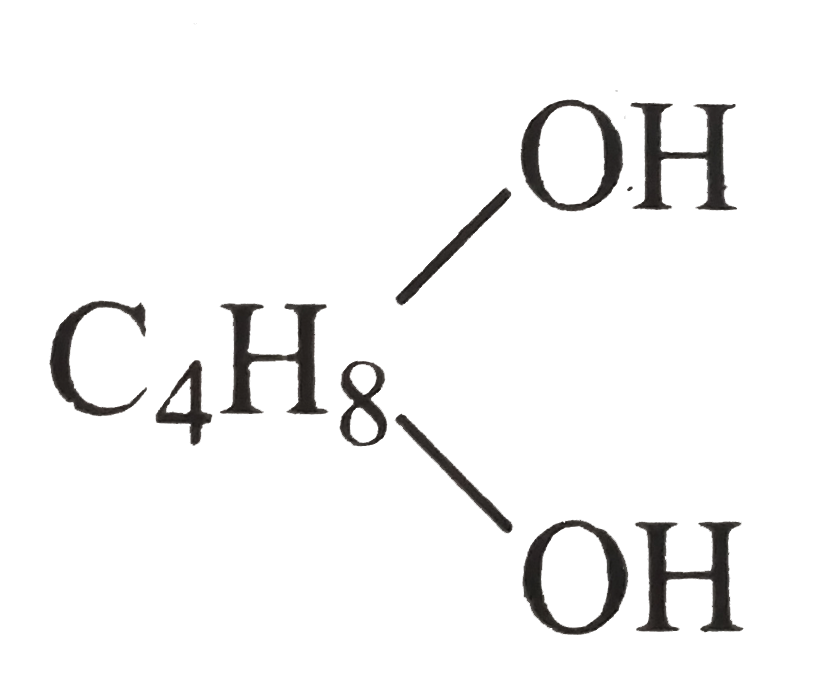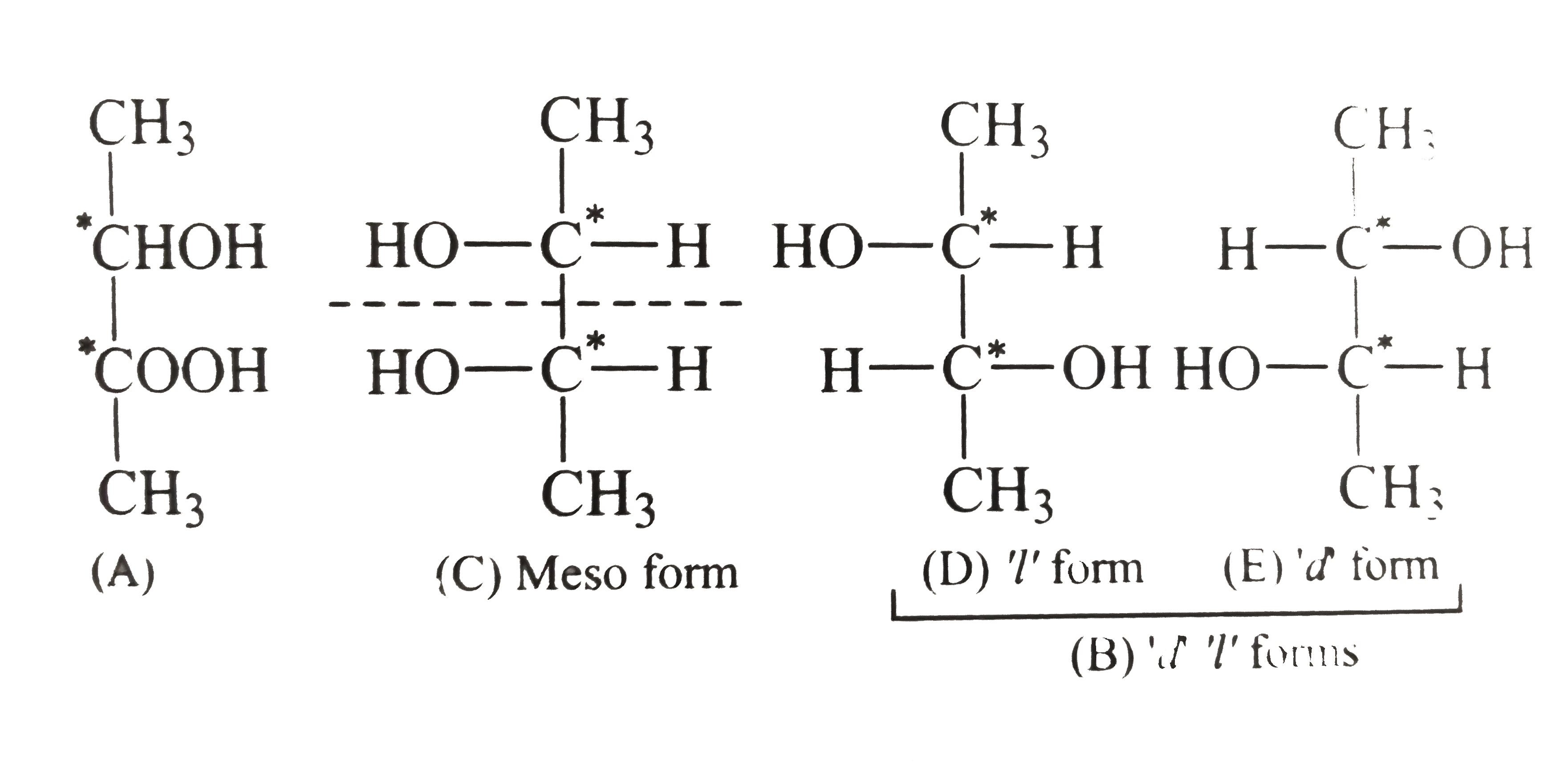0.90gm of an organic compound C4H10O2(A) when treated with sodium gives 224ml of hydrogen at NTP. Compound (A) can be separated into fraction (B) and
(C ), by crystallisation of which the fraction (B) is resolved into isomers (D) and (E ). Write down the structural formula of (A) to (E ) with proper reasoning.
i. (A) reacts with Na to give H2 and thus it contains (−OH) group.
ii. The molecular weight of (A)(C4H10O2) is 90. If one (OH) group, then
90gm(A) with Na gives 11200mlH2 (i.e, half mole H2)
0.90gm o f (A) gives 11200×0.9090=112ml of H2 at STP
Since 0.90Na gives 224mlH2 at STP, it contians two (−OH) groups.
iii. Keeping in view the above facts (A) is , 
iv. (A) shows optical isomerism of which (B) form is optically active having two isomers (D) and (E), (C) being the inactive form, therefore (A),(B),(C), and (D) are:

Topper's Solved these Questions
- ISOMERISMBook:CENGAGE CHEMISTRYChapter:ISOMERISMExercise:(Linked Comprehension Type)Exercise
Explore 14 Videos
- ISOMERISMBook:CENGAGE CHEMISTRYChapter:ISOMERISMExercise:Multiple choice questions (Exercise)
Explore 38 Videos
- ISOMERISMBook:CENGAGE CHEMISTRYChapter:ISOMERISMExercise:Example
Explore 15 Videos
- IONIC EQUILIBRIUMBook:CENGAGE CHEMISTRYChapter:IONIC EQUILIBRIUMExercise:Archives Subjective
Explore 28 Videos
- NCERT BASED EXERCISEBook:CENGAGE CHEMISTRYChapter:NCERT BASED EXERCISEExercise:Chemical Equilibrium
Explore 72 Videos
Similar Questions
0.90gm of an organic compound C4H10O2(A) when treated with sodium gives 224ml of hydrogen at NTP. Compound (A) can be separated into fraction (B) and
(C ), by crystallisation of which the fraction (B) is resolved into isomers (D) and (E ). Write down the structural formula of (A) to (E ) with proper reasoning.
View SolutionAn organic compound (A) C6H12O3 on treatment with concentrated H2SO4 gives CO,H2O and (B). Compound (B) can be prepared by passing vapours of 1-pentanol Over heated copper at 570 K. Compound (A) on heating gives (C), C12H20O4. Give the structures of (A) to ( C) with proper reasoning.
View Solution
Knowledge Check
A neutral compound with molecular formula C3H8O evolves H2 when treated with sodium metal and gives iodoform test. The compound is
A(CH3)2CHOHBCH3CH2CH2OHCCH3COCH3DCH3CH2CHOAn organic compound with moleular formula, C2H6O2 evolves H2 when treated with sodium metal and gives two moles of formaldehyde on oxidation with HIO4. The compound is
AAcetic acidBMethyl acetateCEthylene glycolDEthyl alcohol0.44 gm of organic compound CxHy O which occupied 224 ml at NTP and on combustion gave 0.88 gm CO2. The ratio of X to Y in the compound 1s
A1:1B1:2C1:3D1:4
Two isomeric compounds, (A) and (B), have the same formula, C11H13OCI. Both are unsaturated, yield the same compound (C) on catalytic hydrogenation, and produce 4-chloro-3-ethoxybenzoic acid on vigorous oxidation. (A) exists in geometrical isomers, (D) and (E), but not (B). Give structures of (A) to (E) with proper reasoning.
View SolutionAn organic compound (A) C5H9Br which readily decolourises bromine water and KMnO4 solution gives (B), C5H11Br on treatment with Sn/HCI. The reaction of (A) with NaNH2 produces (C) with evolution of ammonia (C) neither reacts with sodium nor forms any metal acetylide but reacts with Lindlar catalyst to give (D) and on reaction with Na/liq.NH3 produces (E) .Both the compounds (D) and (E) are isomeric. Give structures of (A) to (E) with proper reasoning.
View SolutionAn organic compound (A) of molecular formula C5H8 when treated with Na in liquid ammonia followed by reaction with s-Propyl iodide yeidls (B) C8H12 (A) gives a ketone C5H10O (e) when treated with dil H2SO4 and HgSO4 (B) on oxidation with alkaline KMnO4 gives two isomeric acids (D) and (E) C4H8O2. Give structures of compounds (A) to (E) with proper reasoning .
View SolutionAn organic compound (A) of molecular formula C5H8 when treated with sodium in liquid ammonia followed by reaction with n-propyl bromide yields (B), C8H14. (A) gives a ketone ©, C5H10O when treated with dilute H2SO4 and HgSO4. (B) on oxidation with alkaline KMnO4 gives two isomeric acids (D) and (E) C4H8O2. Give structures of compound (A) to (E) with proper reasoning.
View SolutionCompound (A) C5H5O2 liberated carbon dioxide on reaction with sodium bicarbonate. It exists in two forms neither of which is optically active. It yields compound (B) C5H10O2 on hydrogenation. Compound (B) can be separated into two enantiomorphs Write the structural formulae of (A) and (B) giving reason
View Solution

